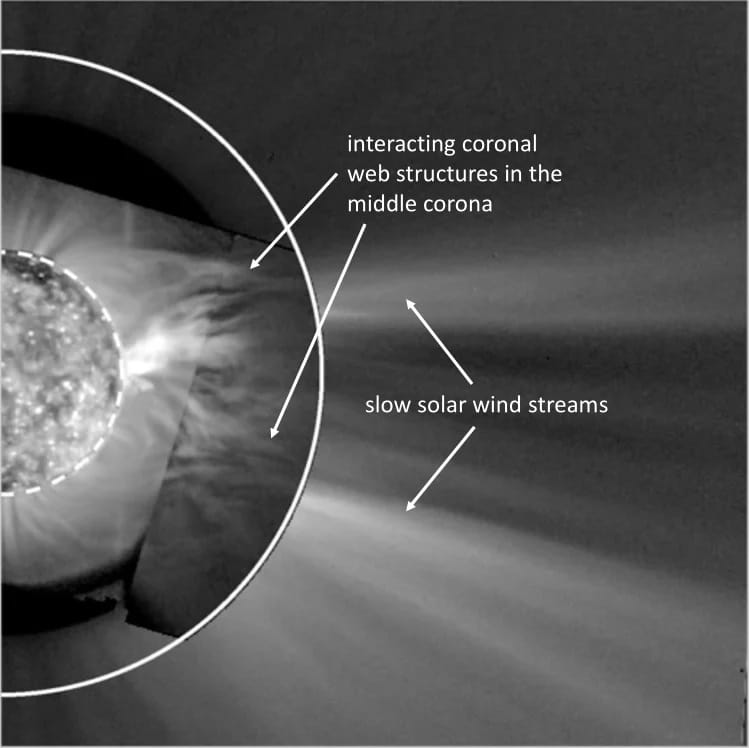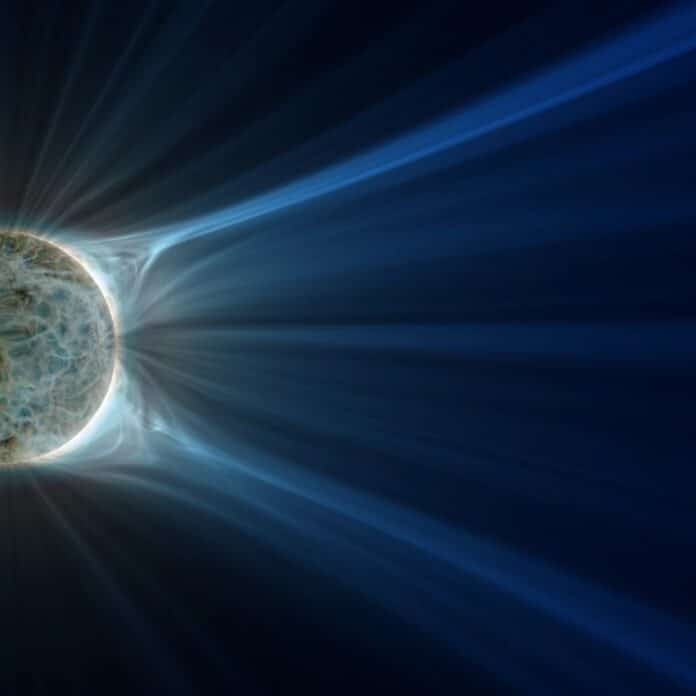A group of scientists from the Max Planck Institute for Solar System Research (MPS) in Germany has made a significant advancement in understanding one of the Sun’s most vexing mysteries: how does our star propel the particles that make up the solar wind into space?
The information offers a distinct perspective of a crucial region of the solar corona that has previously been difficult for researchers to reach. There, the team has, for the first time, recorded a dynamic network of plasma structures that resemble a lengthy, intertwined web. A distinct picture shows up when data from various space probes and comprehensive computer simulations are combined: magnetic energy is discharged, and particles escape into space where the elongated coronal web structures interact.
The Geostationary Operational Environmental Satellites (GOES) of the U.S. National Oceanic and Atmospheric Administration (NOAA) have traditionally concerned themselves with things other than the Sun.
An exploratory observing campaign to image the extended solar corona took place in August and September 2018. For more than a month, GOES’s Solar Ultraviolet Imager (SUVI) looked directly at the Sun as it usually does and captured images to either side of it.
Dr. Dan Seaton of SwRI, who served as chief scientist for SUVI during the observation campaign, said, “We had the rare opportunity to use an instrument in an unusual way to observe a region that has not been explored. We didn’t even know if it would work, but if it did, we’d make important discoveries.”
The intermediate corona, a layer of the solar atmosphere 350 thousand kilometers above the visible surface of the Sun, could be photographed in ultraviolet light for the first time by integrating the photos from the various viewing angles, which considerably increased the instrument’s field of vision.
Dr. Pradeep Chitta of MPS, lead author of the new study, said, “In the middle corona, solar research has had something of a blind spot. The GOES data now provides a significant improvement. In the middle corona, researchers suspect processes that drive and modulate the solar wind.”

One of our star’s most extensive aspects is the solar wind. The heliosphere, a bubble of rarefied plasma that denotes the Sun’s sphere of influence, is created by the stream of charged particles that the Sun launches into space and travels to the limit of our Solar System. The solar wind is split into fast and slow components according to its speed. The interiors of coronal holes, areas that appear dark in coronal ultraviolet radiation, are where the so-called rapid solar wind, which may travel at more than 500 kilometers per second, originates. Less is known, however, about the sluggish solar wind’s origins. However, even the slow solar wind’s particles travel through space at supersonic rates of 300 to 500 km/s.
Hot coronal plasma over one million degrees needs to escape the Sun to form the slow solar wind. What mechanism is at work here? Moreover, the slow solar wind is not homogeneous but reveals, at least in part, a ray-like structure of clearly distinguishable streamers. Where and how do they originate? These are the questions addressed in the new study.
A region near the equator can be seen in the GOES data that caught the attention of the researchers: two coronal holes, where the solar wind flows away from the Sun unhindered, close to an area with a strong magnetic field. These system interactions are considered to be the sluggish solar wind’s potential origins.
The middle corona above this region is depicted by elongated plasma structures that point radially outward in the GOES data. This phenomenon, which has been directly observed for the first time, is referred to by the author team as a coronal web. The web’s structures interact and reorganize frequently.
Researchers have long known the solar plasma of the outer corona to exhibit a similar architecture. For decades, the coronagraph LASCO (Large Angle and Spectrometric Coronagraph) on board the SOHO spacecraft, which celebrated its 25th-anniversary last year, has been providing images from this region in visible light.
The slow solar wind that starts its journey into space there is thought to have a structure similar to that of a jet stream by scientists. As the recent study has impressively demonstrated, this structure already predominates in the middle corona.
The researchers also examined information from other space probes to gain a deeper understanding of the phenomenon: A contemporaneous picture of the Sun’s surface was provided by NASA’s Solar Dynamics Observatory (SDO), while a side view was provided by the STEREO-A spacecraft, which has been orbiting the Sun before Earth since 2006.
Dr. Cooper Downs of Predictive Science Inc., who performed the computer simulations, said, “Using modern computational techniques that incorporate remote sensing observations of the Sun, researchers can use supercomputers to build realistic 3D models of the elusive magnetic field in the solar corona. In this study, the team used an advanced magnetohydrodynamic (MHD) model to simulate the corona’s magnetic field and plasma state for this period.”
Dr. Cooper Downs of Predictive Science Inc., who performed the computer simulations, said, “This helped us connect the fascinating dynamics that we observed in the middle corona to the prevailing theories of solar wind formation.”
Chitta said, “As the calculations show, the structures of the coronal web follow the magnetic field lines. Our analysis suggests that the architecture of the magnetic field in the middle corona is imprinted on the slow solar wind and plays an important role in accelerating the particles into space. According to the team’s new results, the hot solar plasma in the middle corona flows along the open magnetic field lines of the coronal web. Where the field lines cross and interact, energy is released.”
“There is much to suggest that the researchers are on to a fundamental phenomenon. During periods of high solar activity, coronal holes often occur near the equator in close proximity to areas of high magnetic field strength. The coronal network we observed is therefore unlikely to be an isolated case.”
The team hopes to gain further and more detailed insights from future solar missions. Some of them, such as ESA’s Proba-3 mission planned for 2024, is equipped with instruments targeting the middle corona. The MPS is involved in the processing and analyzing of the data of this mission. Together with observational data from currently operating probes such as NASA’s Parker Solar Probe and ESA’s Solar Orbiter, which leave the Earth-Sun-line, this will enable a better understanding of the three-dimensional structure of the coronal web.
Journal Reference:
- L.P. Chitta, D.B. Seaton, C. Downs, C.E. DeForest, A.K. Higginson. Direct observations of a complex coronal web driving highly structured slow solar wind. Nature Astronomy, November 24, 2022. DOI: 10.1038/s41550-022-01834-5
